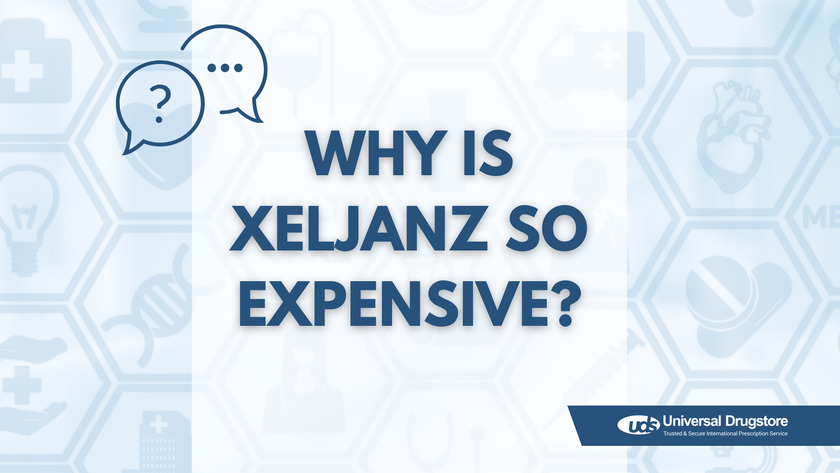Why is Xeljanz so expensive?

Xeljanz was approved by the U.S. Food and Drug Administration (FDA) in late 2012 to treat rheumatoid arthritis. Since it has been on the market, Pfizer has raised Xeljanz’s price with it hitting its highest price in 2017. This $132.84 per tablet price was almost 108 percent higher than its original price in 2012. With no generic available, it is an expensive treatment option, especially if you have no insurance coverage. Keep reading to find out how much Xeljanz costs today and what saving options are out there.
What is Xeljanz prescribed for?
Xeljanz is a brand-name prescription medication that is manufactured by the pharmaceutical company Pfizer. The active ingredient, tofacitinib, is a Janus kinase, or JAK inhibitor. JAKs are enzymes that transmit signals to help activate your body’s immune system. By inhibiting JAKs, Xeljanz helps relieve pain and inflammation from rheumatoid arthritis and other conditions such as psoriatic arthritis, ulcerative colitis, and juvenile idiopathic arthritis.
Xeljanz is typically given to people who have failed 1 or more TNF blockers such as Enbrel (etanercept) or Humira (adalimumab). It is used alone or along with other medications such as Rheumatrex (methotrexate). However, the use of Xeljanz along with biologic disease-modifying antirheumatic drugs (DMARDs) or strong immunosuppressants such as Imuran (azathioprine) and Neoral (cyclosporine) is not FDA-approved because it increases your risk of serious infections.
What are the side effects of Xeljanz?
Some common side effects of Xeljanz seen in clinical trials include upper respiratory tract infections, common cold symptoms, diarrhea, nausea, headache, increased cholesterol levels, shingles, and increased blood pressure.
Xeljanz sometimes causes more serious side effects such as allergic reactions, increased risk of heart attack, stroke, and blood clots, increased risk of certain cancers, holes in your stomach or intestines, anemia, liver damage, and hepatitis B reactivation.
Is there a generic alternative to Xeljanz?
Currently, there is no generic available for Xeljanz, Xeljanz XR, or Xeljanz oral solution in the United States. There are, however, generic versions of the regular and extended-release tablets from other countries such as India and Canada.
When will Xeljanz become generic?
While Zydus Lifesciences has been given approval for their generic versions of Xeljanz from the FDA, it is unsure when they will hit the US market. There are generic versions available online from other countries today.
How much does Xeljanz cost out of pocket?
The out-of-pocket price you pay for Xeljanz will vary. It may depend on the insurance plan you have as well as the pharmacy you use.
If you do not have insurance or if your prescription drug plan doesn’t cover it, Xeljanz can be very expensive. The average cost of a 30-day supply (60 tablets) of Xeljanz 10 mg tablets is over $5300 while a 30-day supply (30 tablets) of Xeljanz XR 11 mg extended-release tablets is around $5600.
If your insurance company does not pay for Xeljanz, talk with your doctor about alternatives that they might cover. While there are cheaper alternatives such as Rheumatrex (methotrexate) and Imuran (azathioprine), most people being prescribed Xeljanz have already tried and failed at least one of these medications.
What other options are available for patients who cannot afford Xeljanz?
The estimated yearly retail cost of Xeljanz without insurance is between over $65,000. Even with insurance, you may not be able to afford the copay of Xeljanz. There are several ways you can save money on Xeljanz, including:
Order the generic version from Universal Drugstore
While there is no generic available in the United States for Xeljanz, you can order it online from Universal Drug Store (UDS). You don’t need a Xeljanz coupon or discount card to save up to 80% on this medication if you purchase it from UDS. We are the global leader in online prescription drug savings with almost 20 years of experience supplying prescription and OTC drugs to our customers. Check out our online pharmacy to find the lowest drug price on Xeljanz, Xeljanz XR, and many other medications.
Copay card
For certain patients who need financial assistance to afford Xeljanz, the Xeljanz Co-Pay Savings Program may help you pay as little as $0 a month if you have commercial insurance. If your pharmacy does not accept the Co-Pay Savings Program, a rebate form is available. The eligibility for this copay card is not based on income.
You can not use the copay card if you have federal or state-issued insurance such as Medicare, Medicare Part D, Medicaid, or Tricare. Check out the Xeljanz savings and support page for more details or call 1-844-935-5269.
Patient assistance program
If you have no insurance coverage and need financial assistance, Medicaid may be right for you if you are eligible. If you do not qualify, you may be eligible for the Pfizer Patient Assistance Program. If eligible, Pfizer will provide you with Xeljanz at no cost. Go to the Xeljanz savings and support page or call 1-844-935-5269 to see if you qualify.
Discount cards
You may be able to save money by using a prescription discount card. These cards can be used at your local pharmacy, even if you have insurance.
Compare prices
Check the price of Xeljanz at multiple pharmacies to find the cheapest option. This should include online and mail-order pharmacies. The retail prices for the same prescription medicine can vary by hundreds of dollars at different pharmacies, even in the same city.
Find an alternative medication
Ask your healthcare provider for medical advice about an alternative drug you can use to treat your condition. You have probably already tried and failed at least one other medication if they are prescribing you Xeljanz. Also, try contacting your insurance company to see what other medications they cover, and then ask your healthcare provider which one might be right for you.
Sources
- https://reference.medscape.com/drug/xeljanz-xeljanz-xr-tofacitinib-999789
- https://pdr.net/drug-summary/Xeljanz-Xeljanz-XR-tofacitinib-2716
- https://freopp.org/the-impact-of-pfizers-price-increases-for-xeljanz-on-pharmaceutical-innovation-a22c8d590bf5
- https://dailymed.nlm.nih.gov/dailymed/drugInfo.cfm?setid=cf74ba2f-afc5-4baa-8594-979c889a5831
- https://www.pfizerpro.com/patient-assistance